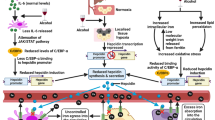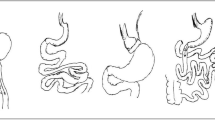Abstract
Background
Human obesity is associated with increased serum phenylalanine concentration, which is probably caused by liver dysfunction related to liver steatosis. This study examines whether improvements of liver function after bariatric surgery is associated with a decrease of serum phenylalanine concentration caused by an increase of phenylalanine metabolism.
Method
Serum phenylalanine and alanine aminotransferase (an independent predictor of liver steatosis) concentrations as well as several parameters related to obesity were measured in 16 obese patients (seven men and nine women) before and 6 months after vertical banded gastroplasty. Ten (six men and four women) lean, healthy subjects served as controls.
Results
Obese patients before surgery had approximately twofold higher serum phenylalanine concentration than control subjects. The serum phenylalanine concentration decreased 6 months after bariatric surgery. Serum alanine aminotransferase (ALT) concentration was higher in obese patients before surgery, and decreased 6 months after bariatric surgery. Changes in serum phenylalanine concentration correlated positively with changes of ALT concentration (r = 0.75; p < 0.001). The body weight, BMI, HOMA-IR, serum triacylglycerol, LDL-cholesterol/HLD-cholesterol ratio, leptin, insulin, and glucose concentrations were higher in obese patients, and decreased 6 months after bariatric surgery. Serum HDL-cholesterol concentration was lower in obese patients before surgery than in control subjects and increased 6 months after surgery.
Conclusion
Results obtained indicate that bariatric surgery-induced weight loss had beneficial effects on several laboratory parameters including serum phenylalanine, ALT, lipid concentrations and insulin resistance. A strong positive correlation between serum phenylalanine and serum ALT concentrations suggests that deterioration of liver function in obese patients is contributing to a decrease in phenylalanine metabolism and consequently to the increase of serum phenylalanine concentration. One can suppose that serum phenylalanine concentration could be noninvasive marker of liver dysfunction associated with liver steatosis in obese patients.



Similar content being viewed by others
References
Pearl RH, Clowes GH, Bosari S, et al. Amino acid clearance in cirrhosis. A predictor of postoperative morbidity and mortality. Arch Surg. 1987;122:468–73.
Zello GA, Pencharz PB, Ball RO. Phenylalanine flux, oxidation, and conversion to tyrosine in humans studied with L [1-13C]phenylalanine. Am J Physiol. 1990;259:E835–43.
Heberer M, Talke H, Maier KP, et al. Metabolism of phenylalanine in liver diseases. Klin Wochenschr. 1980;58:1189–96.
Holm E, Sedlaczek O, Grips E. Amino acid metabolism in liver disease. Curr Opin Clin Nutr Metab Care. 1999;2:47–53.
Burke PA, Stack JA, Wagner D, et al. L (1-13C]-phenylalaniane oxidation as a measure of hepatocyte functional capacity in end-stage liver disease. Am J Surg. 1997;173:270–3.
Ishii Y, Suzuki S, Kohno T, et al. Patients with severe liver cirrhosis followed up by L- [1-13C]phenylalanine breast test. J Gastroenterol. 2003;38:1086–90.
Ishii Y, Suzuki S, Kohno T, et al. L- [1-13C] phenylalanine breath test reflects histological changes in the liver. J Surg Res. 2003;114:120–5.
Neuschwander-Tetri BA, Caldwell SH. Nonalcoholic steatohepatitis: summary of an AASLD Single Topic Conference. Hepathology. 2003;37:1202–19.
Charlton M. Nonalcoholic fatty liver disease: a review of current understanding and future impact. Clin Gastroenterol Hepatol. 2004;2:1048–58.
Poynard T, Ratziu V, Charlotte F, et al. Diagnostic value of biochemical markers (NashTest) for the prediction of non alcoholo steato hepatitis in patients with non-alcoholic fatty liver disease. BMC Gastroenterol. 2006;6:34.
Adams LA, Angulo P, Lindor KD. Nonalcoholic fatty liver disease. CMAJ. 2005;172:899–905.
Papadia FS, Marinari GM, Camerini G, et al. Liver damage in severely obese patients: a clinical–biochemical–morphologic study on 1,000 liver biopsies. Obes Surg. 2004;14:952–8.
Shalhub S, Parsee A, Gallagher SF, et al. The importance of routine liver biopsy in diagnosing nonalcoholic steatohepatitis in bariatric patients. Obes Surg. 2004;14:54–9.
Moretto M, Kupski C, Mottin CC, et al. Hepatic steatosis in patients undergoing bariatric surgery and its relationship to body mass index and co-morbidities. Obes Surg. 2003;13:622–4.
Liew PL, Lee WJ, Lee YCh, et al. Hepatic histopathology of morbid obesity: concurrence of other forms of chronic liver disease. Obes Surg. 2006;16:1584–93.
Dixon JB, Bhathal PS, O’Brien PE. Weight loss and non-alcoholic fatty liver disease: falls in gamma-glutamyl transferase concentration are associated with histologic improvement. Obes Surg. 2006;16:1278–86.
Talwalkar JA. Motion—all patients with NASH need to have a liver biopsy: arguments for the motion. Can J Gastroenterol. 2002;16:718–21.
Laurin J. Motion—all patients with NASH need to have a liver biopsy: arguments against the motion. Can J Gastroenterol. 2002;16:722–6.
Chang Y, Ryu S, Sung E, et al. Higher concentrations of alanine aminotransferase within the reference interval predict nonalcoholic fatty liver disease. Clin Chem. 2007;53:686–92.
Felig P, Marliss E, Cahill GF. Plasma amino acid levels and insulin secretion in obesity. N Engl J Med. 1969;281:811–6.
Caballero B, Finer N, Wurtman RJ. Plasma amino acids and insulin levels in obesity: response to carbohydrate intake and tryptophan supplements. Metabolism. 1988;37:672–6.
Clark JM, Alkhuraishi AR, Solga SF, et al. Roux-en-Y gastric bypass improves liver histology in patients with non-alcoholic fatty liver disease. Obes Res. 2005;13:1180–6.
Swierczynski J, Korczynska J, Goyke E, et al. Serum hepatocyte growth factor concentration in obese women decreases after vertical banded gastroplasty. Obes Surg. 2005;15:803–8.
Friedewald WT, Levy RI, Fredrickson DS. Estimation of the concentration of low-density lipoprotein cholesterol in plasma, without use of the preparative ultracentrifuge. Clin Chem. 1972;18:499–502.
Matthews DR, Hosker JP, Rudenski AS, et al. Homeostasis model assessment: insulin resistance and beta-cell function from fasting plasma glucose and insulin concentrations in man. Diabetologia. 1985;28:412–9.
Palova S, Charvat J, Masopust J, et al. Changes in the plasma amino acid profile in anorexia nervosa. J Int Med Res. 2007;35:389–94.
Marchesini G, Brizi M, Morselli-Labate AM, et al. Association of nonalcoholic fatty liver disease with insulin resistance. Am J Med. 1999;107:450–5.
Clark JM, Brancati FL, Diehl AM. The prevalence and etiology of elevated aminotransferase levels in the United States. Am J Gastroenterol. 2003;98:960–7.
Myers MG, Cowley MA, Munzberg H. Mechanisms of leptin action and leptin resistance. Annu Rev Physiol. 2008;70:537–56.
Nobili V, Manco M, Ciampalini P, et al. Leptin, free leptin index, insulin resistance and liver fibrosis in children with non-alcoholic fatty liver disease. Eur J Endocrinol. 2006;155:735–43.
Chitturi S, Farrell G, Frost L, et al. Serum leptin in NASH correlates with hepatic steatosis but not fibrosis: a manifestation of lipotixicity? Hepatology. 2002;36:403–9.
Kaplan LM. Leptin, obesity, and liver disease. Gastroenterology. 1998;115:997–1001.
Zabrocka L, Raczynska S, Goyke E, et al. BMI is the main determinant of the circulating leptin in women after vertical banded gastroplasty. Obes Res. 2004;12:505–12.
Maggard MA, Shugarman LR, Suttorp M, et al. Meta-analysis: surgical treatment of obesity. Ann Intern Med. 2005;142:547–59.
Acknowledgement
This work was supported in part by the Ministry of Science and Higher Education in the years 2006–2009 as a research project (N40100931/0150) and ST-41.
Author information
Authors and Affiliations
Corresponding author
Rights and permissions
About this article
Cite this article
Swierczynski, J., Sledzinski, T., Slominska, E. et al. Serum Phenylalanine Concentration as a Marker of Liver Function in Obese Patients Before and After Bariatric Surgery. OBES SURG 19, 883–889 (2009). https://doi.org/10.1007/s11695-008-9521-z
Received:
Accepted:
Published:
Issue Date:
DOI: https://doi.org/10.1007/s11695-008-9521-z




